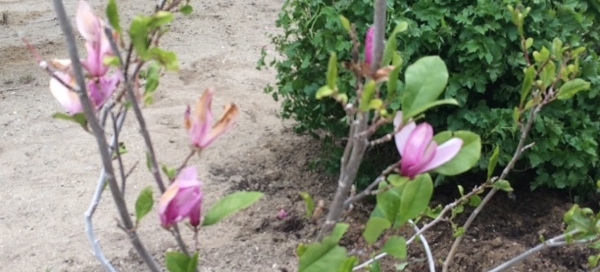Magnolia Leaf Drop
Your Magnolia is clearly under stress. Here are several possible causes based on what we can see in the photo. Although deer damage is possible, one way to tell if damage is from deer is that the damage is deer height, the lower portion of the plant. Upper regions beyond their reach are often left untouched. We can't see the top of the Magnolia to verify if the upper leaves are intact. However, if the leaf drop is throughout the tree, while there may be some deer damage, overall leaf drop suggests the problem stems from other causes such as the tree not receiving enough or too much water or nutrients. Magnolia like to be kept moist, even when dormant in the winter. A layer of several inches of organic mulch helps retain moisture and helps minimize soil temperature extremes. If your Magnolia isn't in a drip irrigation system, you'll want to make sure that it receives regular water. Newly transplanted trees can suffer stress if they dry out.
Magnolias also prefer acidic soil. The soil in your area is usually alkaline. You may want to contact the nursery or vendor where you purchased the tree for their recommendations on soil amendments specifically for Magnolia. While these beautiful trees do have some pests that can bother them, healthy plants tend to be less bothered by them.
As a fairly new transplant, your tree is still adapting to its new planting site. Some of the suggestions provided may improve your Magnolias overall health. Some leaves appear to be returning already! If your tree doesn't respond to these changes, you may want to contact either the nursery or vendor where you purchased the tree or your local extension agency for more specific help. Here's a link to the Nevada Extension Agency - http://www.unce.unr.edu/
Here's a link for more information on general Magnolia care, including fertilization - http://www.gardeningknowhow.com/ornamental/trees/magnolia/magnolia-tree-care.htm
